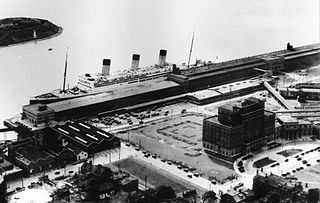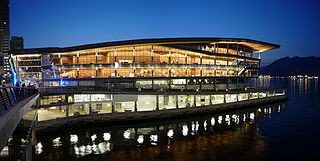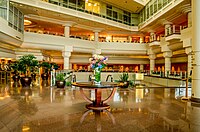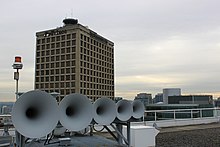Arthur Charles Erickson was a Canadian architect and urban planner. He studied Engineering at the University of British Columbia and, in 1950, received his B.Arch. (Honours) from McGill University. He is known as Canada's most influential architect and was the only Canadian architect to win the American Institute of Architects AIA Gold Medal. When told of Erickson's award, Philip Johnson said, "Arthur Erickson is by far the greatest architect in Canada, and he may be the greatest on this continent."

Canada has a large domestic and foreign tourism industry. The second largest country in the world, Canada's wide geographical variety is a significant tourist attractor. Much of the country's tourism is centred in the following regions: Toronto, Montreal, Quebec City, Vancouver/Whistler, Niagara Falls, Vancouver Island, Canadian Rockies, British Columbia's Okanagan Valley, Churchill, Manitoba and the National Capital Region of Ottawa-Gatineau. The large cities are known for their culture, diversity, as well as the many national parks and historic sites.

Waterfront station is a major intermodal public transportation facility and the main transit terminus in Vancouver, British Columbia, Canada. It is on West Cordova Street in Downtown Vancouver, between Granville and Seymour Street. The station is also accessible via two other street-level entrances, one on Howe Street to the west for direct access to the Expo Line and another on Granville Street to the south for direct access to the Canada Line.

Pier 21 is a former ocean liner terminal and immigration shed from 1928 to 1971 in Halifax, Nova Scotia, Canada. Nearly one million immigrants came to Canada through Pier 21, and it is the last surviving seaport immigration facility in Canada. The facility is often compared to the landmark American immigration gateway Ellis Island. The former immigration facility is now occupied by the Canadian Museum of Immigration, the Nova Scotia College of Art and Design as well as various retail and studio tenants.

The Komagata Maru incident involved the Japanese steamship Komagata Maru, on which a group of people from British India attempted to immigrate to Canada in April 1914, but most were denied entry and forced to return to Budge Budge, Calcutta. There, the Indian Imperial Police attempted to arrest the group leaders. A riot ensued, and they were fired upon by the police, resulting in some deaths.

The Vancouver Convention Centre is a convention centre in Vancouver, British Columbia, Canada; it is one of Canada's largest convention centres. With the opening of the new West Building in 2009, it now has 43,340 square metres (466,500 sq ft) of meeting space. It is owned by the British Columbia Pavilion Corporation, a Crown corporation owned by the government of British Columbia. The Centre served as the main press centre and International Broadcast Centre for the 2010 Winter Olympics.

The history of Vancouver, British Columbia, is one that extends back thousands of years, with its first inhabitants arriving in the area following the Last Glacial Period. With its location on the western coast of Canada near the mouth of the Fraser River and on the waterways of the Strait of Georgia, Howe Sound, Burrard Inlet, and their tributaries, Vancouver has – for thousands of years – been a place of meeting, trade, and settlement.

HMCS Rainbow was an Apollo-class protected cruiser built for Great Britain's Royal Navy as HMS Rainbow entering service in 1892. Rainbow saw time in Asian waters before being placed in reserve in 1909. In 1910 the cruiser was transferred to the Royal Canadian Navy for service on the west coast. At the outbreak of the First World War, Rainbow was the only major Canadian or British warship on the western coast of North America. Due to age, the cruiser was taken out of service in 1917 and sold for scrap in 1920 and broken up.

Baba Gurdit Singh was the central figure in the Komagata Maru incident of 1914, one of several incidents in the history of early 20th century involving exclusion laws in both Canada and the United States designed to keep out immigrants of only Asian origin.

Victoria Harbour is a harbour, seaport, and seaplane airport in the Canadian city of Victoria, British Columbia. It serves as a cruise ship and ferry destination for tourists and visitors to the city and Vancouver Island. It is both a port of entry and an airport of entry for general aviation. Historically it was a shipbuilding and commercial fishing centre. While the Inner Harbour is fully within the City of Victoria, separating the city's downtown on its east side from the Victoria West neighbourhood, the Upper Harbour serves as the boundary between the City of Victoria and the district municipality of Esquimalt. The inner reaches are also bordered by the district of Saanich and the town of View Royal. Victoria is a federal "public harbour" as defined by Transport Canada. Several port facilities in the harbour are overseen and developed by the Greater Victoria Harbour Authority, however the harbour master's position is with Transport Canada.

Ogden Point is a deep water port facility located in the southwestern corner of the city of Victoria, British Columbia, Canada. Its advantageous geographic location on the southern tip of Vancouver Island, by the Strait of Juan de Fuca, close to major population centres Vancouver and Seattle, has made it an attractive cruise ship destination. It also serves as a ship repair and supply facility for cruise ships and other vessels such as deep sea cable laying ships. Ogden Point also has a heliport with frequent service to Vancouver Harbour, Vancouver International Airport, and Seattle. The port lies at the eastern entrance of Victoria Harbour. For smaller boats there is boat ramp for trailerable boats.

Komagata Maru was a cargo steamship that was built in Scotland in 1890, was in German ownership until 1913, and then had a succession of Japanese owners until she was wrecked in 1926. She was launched as Stubbenhuk, renamed Sicilia in 1894, Komagata Maru in 1913 and Heian Maru in 1924.

The 1986 World Exposition on Transportation and Communication, or simply Expo 86, was a World's Fair held in Vancouver, British Columbia, Canada from May 2 until October 13, 1986. The fair, the theme of which was "Transportation and Communication: World in Motion – World in Touch", coincided with Vancouver's centennial and was held on the north shore of False Creek.

The continuous journey regulation was a restriction placed by the Canadian government that (ostensibly) prevented those who, "in the opinion of the Minister of the Interior," did not "come from the country of their birth or citizenship by a continuous journey and or through tickets purchased before leaving the country of their birth or nationality" from being accepted as immigrants to Canada. However, in effect, the regulation would only affect the immigration of persons from India.
Joseph Edward Bird was a Canadian legal figure. Bird was the primary lawyer, hired by the Khalsa Diwan Society to represent the passengers on board the Komagata Maru in Vancouver, 1914. Bird fought actively against the threat of his clients' eventual deportation, and he made great effort to challenge Canada's highly restrictive immigration laws. Bird was an advocate for equality, and sought to reform the race-based exclusion laws in Canada. Bird attempted to prove that the passengers of the Komagata Maru should have been able to settle in Canada as British subjects, though he was ultimately unsuccessful; public and political sentiments and policies at the time were overtly racist, and the BC Court of Appeal ordered the Komagata Maru to return to India.
Pan Pacific Vancouver Hotel is a hotel in Canada Place near Waterfront Station in Vancouver, British Columbia, Canada.

The architecture of Vancouver and the Greater Vancouver area consists of a variety of modern architectural styles, such as the 20th-century Edwardian and the 21st-century modernist styles. Initially, the city architects embraced styles developed in Europe and the United States, with only limited local variation.
Continuous Journey is a 2004 documentary film directed by Indian-Canadian film-maker Ali Kazimi. The film chronicles the events that took place during the 1914 voyage of the Komagata Maru.

Mewa Singh Lopoke was a Sikh activist in Canada who was a member of the Vancouver branch of the Ghadar Party, which called for the overthrow of British rule in India. On October 21, 1914, Mewa Singh murdered a Canadian immigration inspector, W. C. Hopkinson, a political act of violence for which he was executed by the Canadian government. In the eyes of Sikh Canadians, Mewa Singh's assassination of Hopkinson was a display of martyrdom, one which they commemorate annually.
The Springdale Brampton Library and Komagata Maru Park, designed by RDH Architects, is near the intersection of Bramalea Road and Sandalwood Parkway in Springdale, Brampton, Ontario, Canada. It is an example of " progressive organic architecture and urbanism that focuses on an experience set within the typical fabric of a North American suburb." Inaugurated in 2019, the opening of Brampton Library's Springdale Branch introduced a single storey structure. It rests on a triangular footprint of the library that optimizes the utilization of green areas.





















